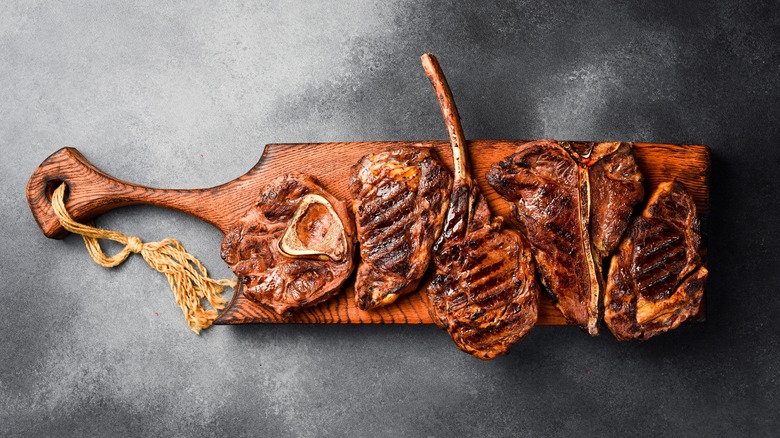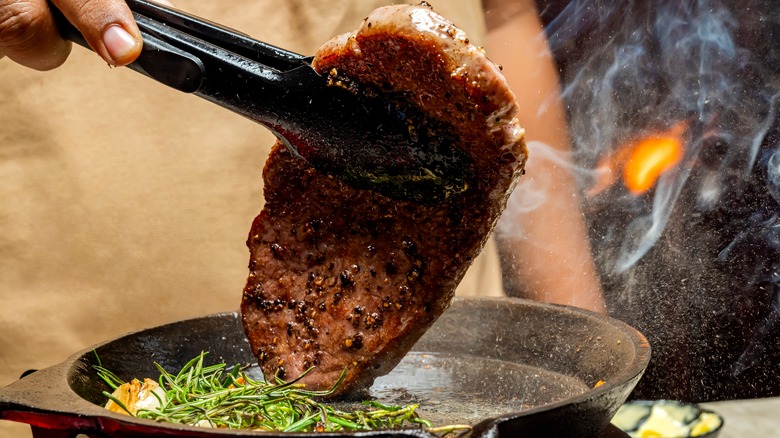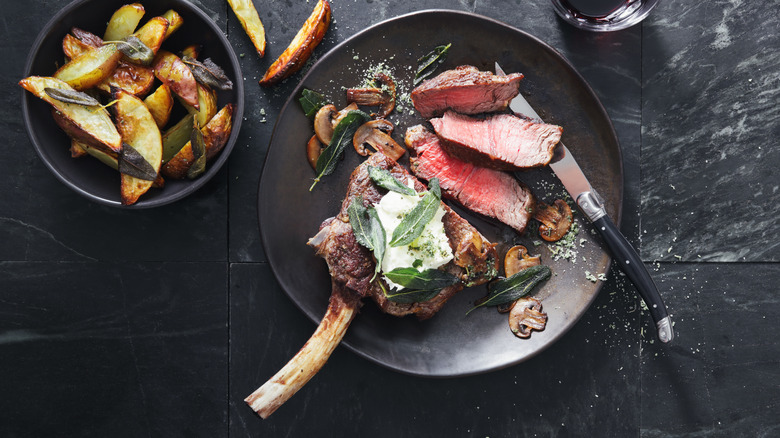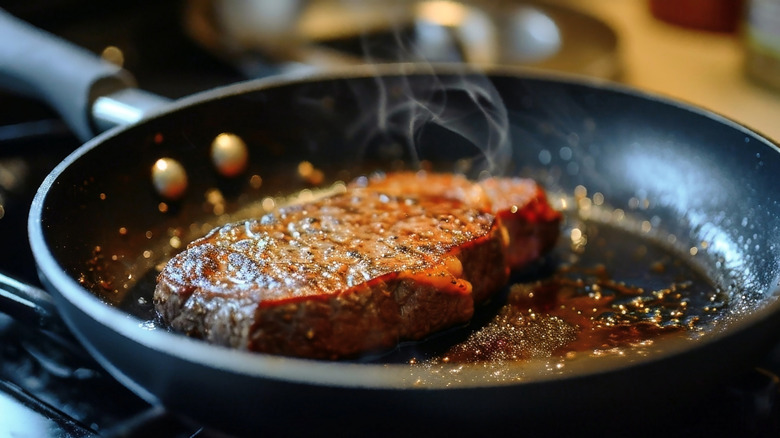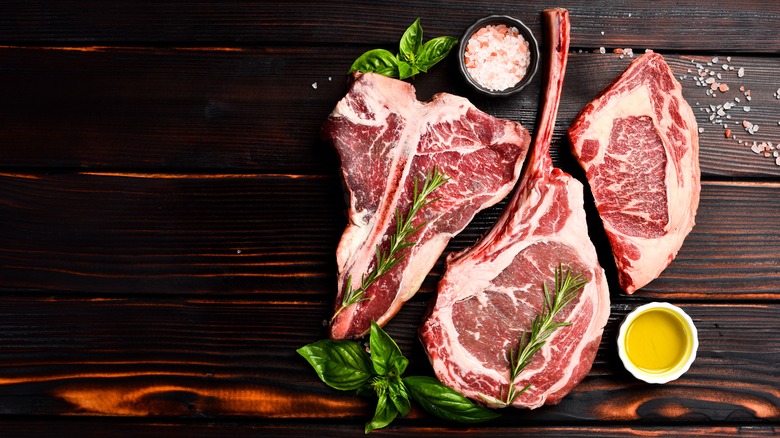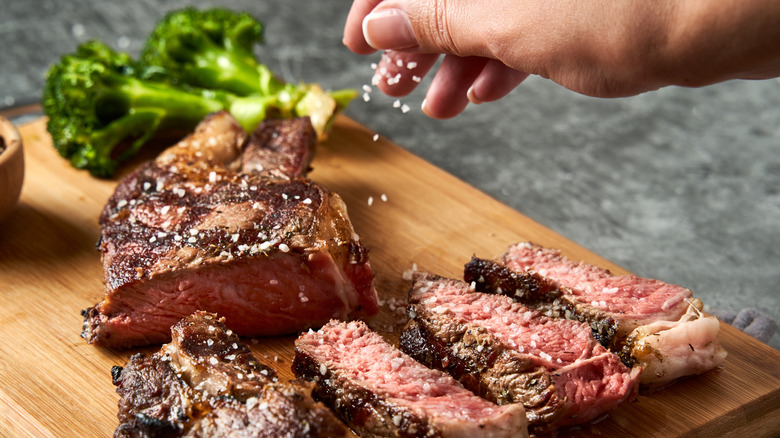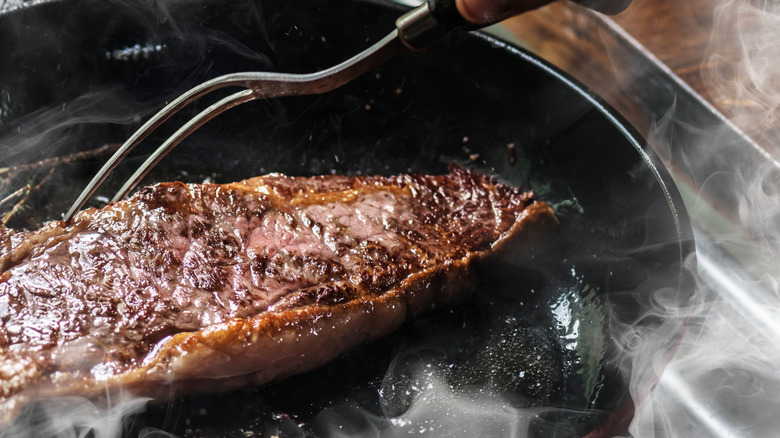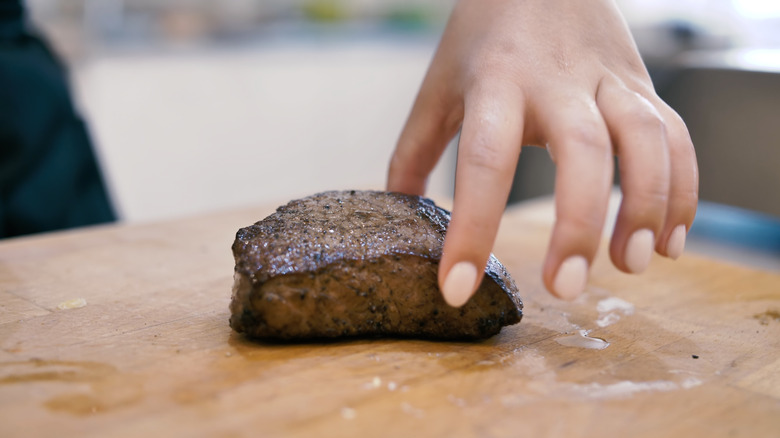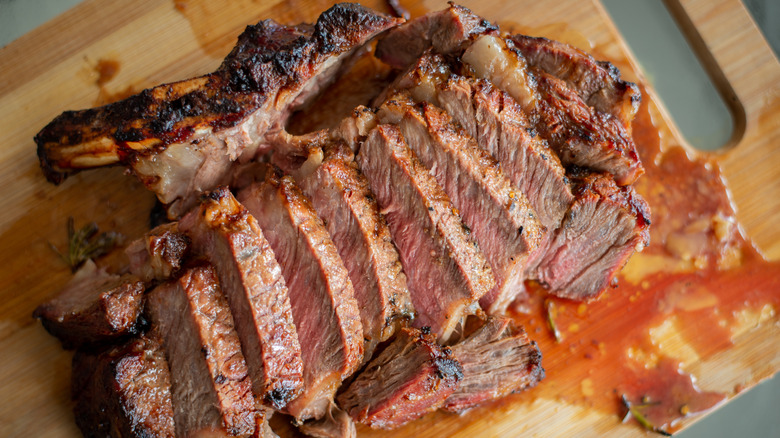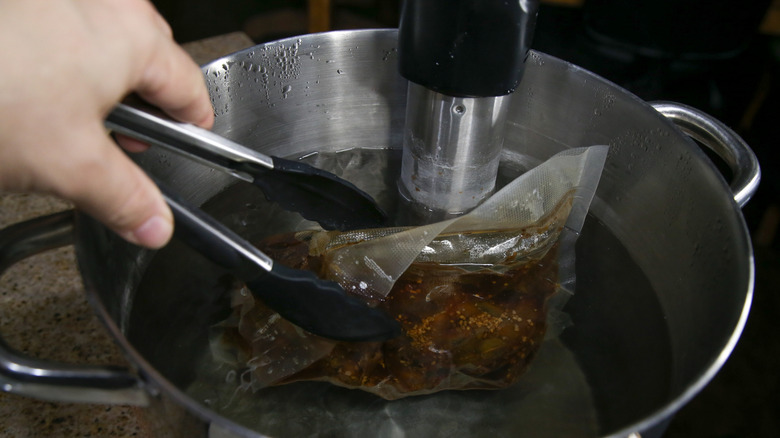The Biggest Steak Myths You've Believed This Entire Time
We may receive a commission on purchases made from links.
Few foods come with as many rules and cooking superstitions as a good steak. Don't flip it more than once. Let it come to room temperature. Sear it to lock in the juices. Sound familiar? The steak world is full of strong opinions and contradictory advice, making it difficult to separate fact from fiction. Some of these rules have been passed down for generations but are contradicted by modern food science. What if that advice you've followed religiously for years is actually holding your steaks back?
Food scientists have put these cooking maxims under the microscope, and the results might surprise you. That finger test for doneness? About as reliable as a mood ring. The belief that bone-in steaks taste better? There's a fascinating reason why and it's not what you'd think. Whether you're a dedicated carnivore obsessing over the perfect crust or a home cook trying to avoid turning dinner into shoe leather, understanding the science behind these myths will transform your steak game. Let's cut through the gristle and get to the juicy truth about cooking the perfect steak.
Don't flip your steak
You should only flip your steak once during cooking. This idea is repeated everywhere, even among professional chefs. The theory suggests that flipping too often prevents proper browning, disrupts the cooking process, and results in moisture loss. But experimentation among more forward-thinking chefs have led to the discovery that this just isn't true.
Food scientist Harold McGee first challenged this conventional wisdom in 1999, when he published a study in the journal Physics Today titled "The Virtual Cook: Modeling Heat Transfer in the Kitchen." His research showed that frequent flipping actually creates a more evenly cooked steak in less time. Later experiments by multiple chefs confirmed these findings, demonstrating that steaks flipped frequently developed better crusts and more even internal cooking than those flipped just once.
Multiple flipping helps distribute the heat more gently and evenly throughout the steak. Each time you flip, the side facing up gets a brief moment to cool slightly, which helps prevent overcooking at the surface while allowing heat to continue moving toward the center. It also cooks the steak a lot faster than the traditional approach. This happens because you're effectively cooking from both sides more consistently, rather than intensely heating one side at a time.
Bone-in steak imparts more flavor
Many steak lovers swear by bone-in cuts like ribeyes and T-bones. A popular belief suggests that the bone marrow infuses rich flavors throughout the meat during cooking. It's a romantic notion that seems to make culinary sense.
However, bone-in steak isn't actually more flavorful than boneless. The bone structure is simply too dense to allow marrow flavors to penetrate through and season the surrounding meat. Those delicious bone marrow compounds remain locked inside rather than migrating outward.
That said, cooking steaks with the bone still attached does do something. The bone conducts heat much more slowly than meat does. Therefore, the meat closest to the bone cooks more gently and retains more moisture. You'll often notice this area appears more pink or red and has a particularly succulent texture.
There is also a more primal reason that some people enjoy a bone-in steak — the ritual of picking those last bits of meat off the bone. In a reddit thread discussing the topic, one user exclaimed "I just like eating the bone at the end like a caveman!" Whether you choose bone-in or boneless ultimately comes down to personal preference, but next time you're enjoying a bone-in steak, appreciate it for what it truly offers rather than what the myths suggest.
Searing your steak locks in the juices
Some people think that searing meat at high heat creates a seal that traps all the flavorful juices inside and prevents moisture from escaping during the rest of the cooking process. However, science simply doesn't support the idea that searing "locks in" juices. Meat is naturally very porous, and searing cannot possibly form an impermeable barrier around the outside. If you've ever seared a steak and let it rest, you've probably noticed the small puddle of juices that collect beneath it, proving that moisture can and does escape.
Understanding what really happens requires looking at meat's structure. Meat is about 70% water, with much of that moisture locked within thousands of long, thin muscle fibers. Heating meat always squeezes out juices and nothing can stop the process. Searing actually causes more immediate water loss at the surface, not less. The crusty exterior forms precisely because the surface has dried out due to the high heat. The hard sear destroys the exterior cells as meat fibers contract dramatically, forcing water out.
So why bother searing at all? The magic happens through what scientists call the maillard effect. When meat hits high heat, the proteins break down and mix with natural sugars in the meat. This reaction only happens at temperatures above 280 F and creates that beautiful brown crust along with deep, savory flavors that simply can't be achieved any other way. The result is the rich, almost caramelized taste that makes a seared steak so much more delicious than one cooked without that initial high heat treatment.
Steak needs to be cooked at room temperature
A lof of chefs and cookbooks will tell you that you should take your steak out of the refrigerator 20-30 minutes before cooking so that it's at room temperature, as apparently this leads to more even cooking, better browning, and a juicier final result.
In reality, when a cold steak from the refrigerator sits on your counter for the recommended 20-30 minutes, its internal temperature barely changes at all. It would take hours for your steak to actually come to room temperature and by that time, it could be in danger of spoiling.
There is another reason to completely ignore this myth. The temperature gap between a cold steak and a hot pan actually works in your favor. It allows the steak to develop a beautiful sear on the outside while maintaining the desired doneness inside. A room temperature steak would cook much faster throughout, potentially resulting in a tough, overcooked steak by the time you achieve a proper char on the exterior.
So go ahead and cook your steak straight from the refrigerator. The minimal temperature change from a short rest isn't worth the wait, and in many cases, the cold start will give you better results anyway.
Don't salt your steak until after it's cooked
People have a lot of opinions about when you should salt your steak, some claim you should only salt it right before cooking or even after it's done. Apparently salting too early draws out moisture, resulting in a dry, tough steak. Some recipes specifically warn against salting in advance to avoid dehydrating the meat.
This advice gets the science completely backward. Salting your steak well before cooking actually creates a juicier, more flavorful final result through a process called dry brining. Here's what actually happens when you salt a steak. Initially, the salt does pull moisture from the meat to the surface. If you salt a steak and check it after about 10 minutes, you'll see beads of moisture on the surface, seemingly confirming the myth. But if you continue watching, something magical happens. Over the next 20-40 minutes, that moisture dissolves the salt into a brine solution. This solution then slowly gets reabsorbed back into the meat, carrying dissolved salt with it. Once inside, the salt begins to break down and loosen some of the protein structures in the muscle fibers. This not only seasons the meat throughout but also improves its ability to retain moisture during cooking.
If you don't have 30 minutes, salting right before cooking is still better than not salting at all. But that sweet spot of half an hour gives you the best balance of flavor penetration, moisture retention, and surface drying for stellar browning.
You don't need to bother basting
Some see basting as just a fussy, unnecessary step that professional chefs do for show — a bit of culinary theater meant to impress diners or camera crews rather than actually improve the dish. Many home cooks skip this step entirely, assuming it doesn't make enough difference to justify the extra effort, attention, and time investment. After all, when you're hungry, the kitchen is hot, and dinner is already running late, who wants to stand over a sizzling pan repeatedly spooning hot fat over a steak for several additional minutes?
The truth is that basting is worth every second of your time. Beyond the rich flavor of butter itself, the fat works wonderfully at carrying the flavors of the herbs and garlic. It really does add another layer of complexity and depth to the final dish that should not be skipped, transforming an ordinary steak into something that feels special and restaurant worthy.
Basting also creates more even browning across the entire steak. The hot butter reaches all those nooks and crannies that aren't making good contact with the pan, giving you that gorgeous caramelization across the entire surface. Plus, there's a significant advantage that most cooks overlook. A well basted steak maintains a higher surface temperature during resting. This means your steak will still be delightfully warm when you're ready to eat, not lukewarm after its rest period.
Poking steak will cause it to lose its juices
Some say that poking your steak with a fork or thermometer will cause it to lose its valuable juices. This will supposedly result in a dry, flavorless piece of meat. In reality, meat just doesn't work like that. The structure of muscle tissue consists of many small fiber bundles that each hold moisture independently. When you stick a thin probe into a steak, only the tiny area directly touched by the probe releases moisture.
ThermoWorks put this to the scientific test with impressive precision. They compared moisture loss between unprobed steaks and those pierced with thermometers. The results were eye-opening. Steaks cooked to the same temperature showed statistically insignificant differences in moisture loss whether they were probed or not. Unprobed steaks lost an average of 14.71 grams of liquid, while probed steaks lost 13.51 grams. Even more telling, when they stabbed steaks multiple additional times after cooking, the extra moisture loss was barely measurable at just 0.84 grams across three puncture holes.
What actually matters for juiciness is getting the temperature right. Steaks overcooked by just 5 F lost considerably more moisture (16.03 grams) than properly cooked steaks with multiple probe holes. This makes sense, as higher temperatures cause protein fibers throughout the entire steak to contract and squeeze out their moisture.
The finger test
This popular test involves comparing the firmness of your cooking steak to the fleshy area at the base of your thumb when you touch different fingers together. Supposedly, the varying tension in your palm perfectly mimics the changes in steak as it moves from rare to well-done.
Consumer Reports put this method to the test, cooking identically sized sirloin steaks and comparing finger test assessments with actual internal temperatures. The results revealed consistent underestimation across all doneness levels. When testers thought they had a rare steak based on the finger test, the internal temperature was only 106 F, well below the 125 F target for rare. The medium-rare assessment yielded 110 F, nowhere near the ideal 135 F. Medium came in at 127 F instead of 145 F, and medium-well registered at 142 F instead of 155 F. Even well-done, which should hit 165 F, only reached 157 F using the finger method.
A small Australian study in 2015 also put the finger test's reliability to scientific scrutiny, with disappointing results. Researchers found the finger test achieved only 36% accuracy when compared to internal temperature readings. This makes it little better than guesswork for ensuring food safety or achieving your desired level of doneness.
When it comes to checking your steak's doneness, there are really only two reliable methods. The first is using a good meat thermometer, which gives you an exact temperature reading for perfect results every time. The second is simply cutting into your steak to visually inspect the color inside.
The red liquid in steak is blood
Ever heard someone call a rare steak "bloody"? Many people think the red juice pooling on your plate from a juicy steak is blood. This common misconception makes some squeamish about ordering steaks rare or medium-rare, thinking they're consuming animal blood.
That ruby red liquid isn't blood at all. It's actually a protein called myoglobin mixed with water, which makes up about 75% of meat. Blood is almost entirely removed during slaughter and processing, long before the meat reaches your plate.
Myoglobin stores oxygen specifically in muscle tissues. When exposed to air, the iron in myoglobin turns bright red, creating that convincing blood like appearance. The color of this myoglobin rich liquid changes with heat, which explains the various colors of steak at different doneness levels. At rare temperatures around 140 F, myoglobin remains mostly intact and red. As temperatures rise toward medium and well-done, the protein begins to turn brown or even greyish. This isn't blood cooking away, it's simply a protein changing structure with heat
Even meat in your refrigerator undergoes color changes. When that bright red steak starts turning brownish after a few days, it's just myoglobin undergoing chemical changes through oxidation. While this might look concerning, the color itself doesn't mean the meat has spoiled. Your nose is a more reliable tool than your eyes for determining freshness. So next time you cut into a perfectly cooked medium-rare steak, remember that rich red juice making your mashed potatoes pink isn't blood, just muscle proteins doing what they naturally do.
Sous vide is just a fad
Sous vide is a cooking method that's gaining popularity, but some skeptics believe it's just another overblown food trend that doesn't live up to the hype, claiming involves unnecessarily complex and expensive kitchen gadgetry that delivers results no better than traditional cooking methods.
For the uninitiated, sous vide (pronounced "soo-veed," meaning "under vacuum" in French) involves sealing food in a bag and cooking it in a precisely temperature controlled water bath. After cooking, steaks are typically finished with a quick sear to develop flavor and color.
Far from being just a passing fad, sous vide delivers results that are genuinely hard to achieve through other cooking methods. The flavor and texture benefits are what convert most skeptics. Since the meat cooks at precisely your target temperature throughout, you achieve perfect edge-to-edge doneness without any overcooked areas. The sealed environment prevents moisture from escaping, resulting in remarkably juicy meat that retains all its natural flavors. This technique transforms both premium and budget cuts alike. Tender cuts like ribeye become even more luxurious, while tougher, collagen-heavy cuts like chuck or round become surprisingly tender when held at low temperatures for extended periods.
Granted, it is another piece of kitchen equipment to add to the shelves. But trust us, if you are serios about your steak, this one is worth it. It doesn't have to break the bank either, there are some affordable sets that you can get for around $60.

